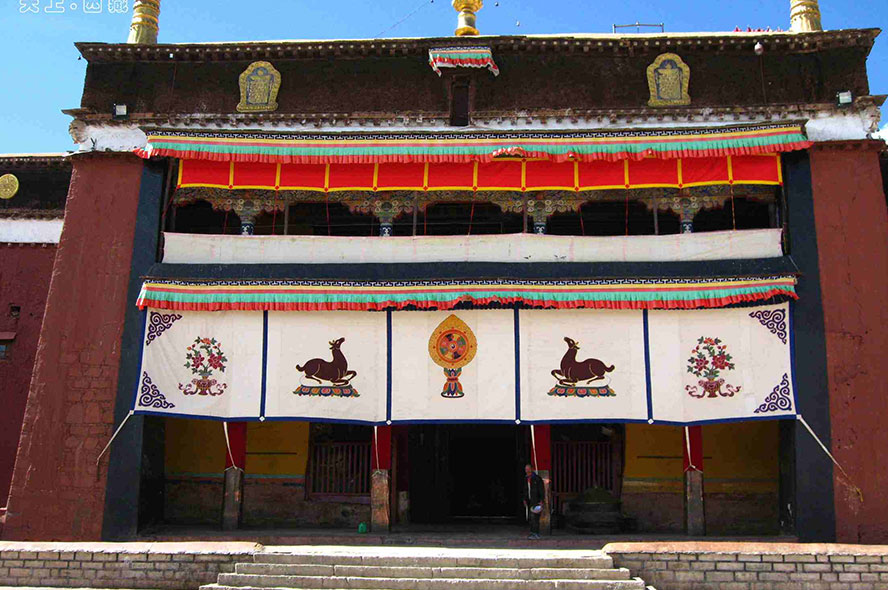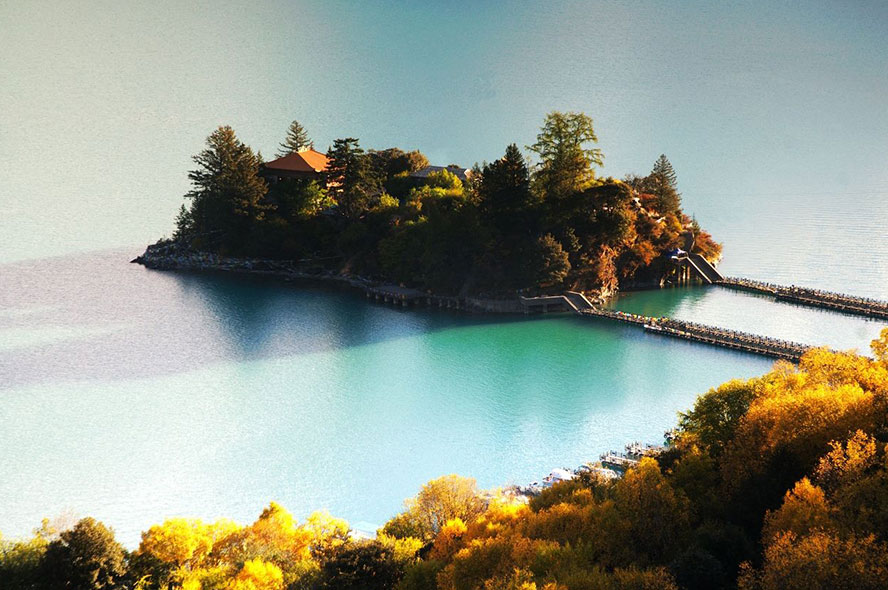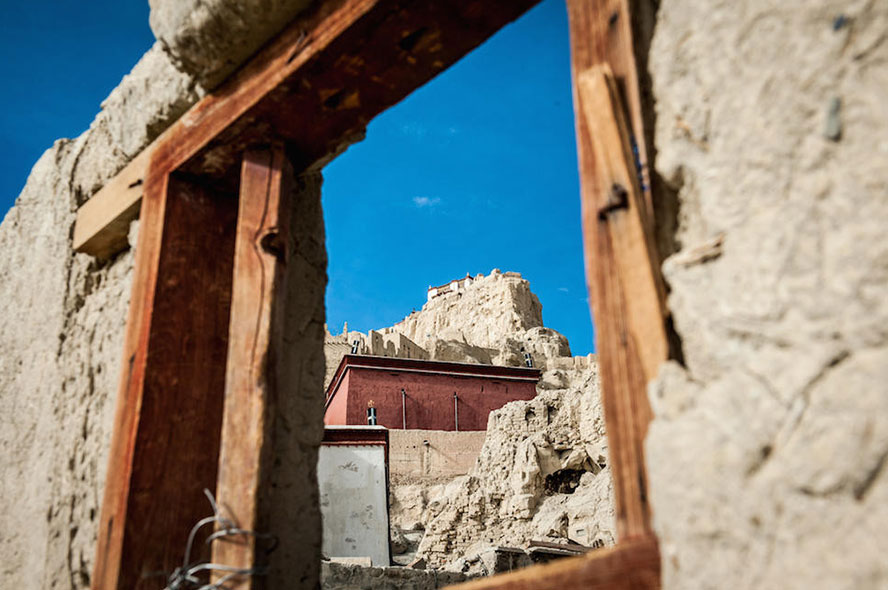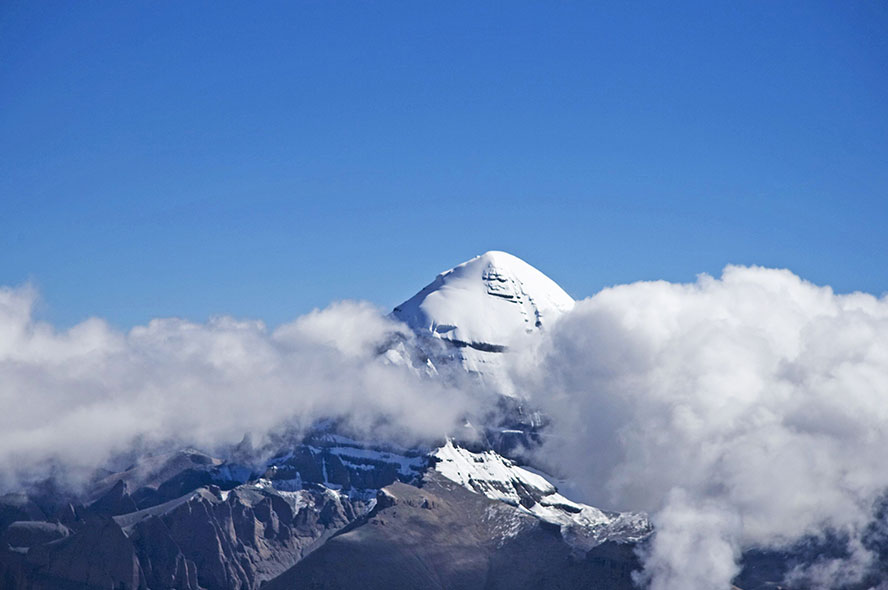Tibet, a holy land on the roof of the world—Qinghai-Tibet Plateau, is considered to be the last pure land on earth. The huge differences of altitude, climate, and landscape between Tibet and other places of the world are major reasons that can explain why the environment of Tibet is totally different from that of other places. The environmental protection system in Tibet is believed to be one of the best and the most successful in the world. While other places are trying to protect endangered animals and plants by separating them from human beings, Tibet, on the contrary, holds the belief that human and other creatures should harmoniously coexist with each other. Therefore, for those who want to go to see wild animals in the zoos in Tibet, they might be disappointed, as there are only two zoos in Tibet (the Norpulingkha Zoo and Qushui Zoo), and the amount of animals in the zoos is much lower than they expect. Even though there aren’t many zoos in Tibet, the amount of wild and rare animals in the region is still one of the largest in the world, because killing of animals are prohibited in Tibet. So tourists who travel to Tibet are able to get many chances to see animals which only live there.
Plants in Tibet
Tibet is a natural plant museum. Because of the high altitude, complicated climates as well as the various landscapes, it boasts rich resources of rare plants, among which more than 100,000 species are high-grade plants. Over 2,000 species of plants (flowers and herbs are included) are of high medical value, and about 400 of them are herbs that can be used for medical purposes by normal people in daily life, such as the Chinese caterpillar fungus, Fritillaria Thunbergii, Rhizoma Picrorhizae, rhubarb, Rhizoma Gastrodiae, pseudo-ginseng, Codonopsis Pilosula, Radix Gentiane Macrophyllae, Radix Salviae Miltiorrhizae, glossy ganoderma, and Caulis Spatholobi.
Vascular plants refer to those land plants which have lignified tissues for conducting water and minerals throughout the plant. There are about 250,000 to 300,000 species of existing vascular plants in the world. And Tibet owns over 12,000 species, which belong to 1,500 genera of vascular plants. Rhododendron, a kind of vascular plant, is commonly seen in Tibet. There are a total of around 800 species of rhododendron in the world, and Tibet itself possesses half of the species.
In addition to the rhododendron, fungus are also special creatures in Tibet. Fungus in Tibet are of great values for study and application. Over 200 species of fungus have been discovered in Tibet, which belong to 185 families of fungus. 345 of the species are edible fungus such as songrong, hedgehog hydnum, zhangzi fungus, mushrooms, black fungus, tremellas and yellow fungus. And 188 are pharmaceutic fungus, such as tuckahoes, songganlans, and stone-like omphalias. Both the edible fungus and pharmaceutic fungus are good choices to be a present for friends and relatives.
Wild Animals in Tibet
Due to the complex territory, changeable climates, and various vegetation, Tibet have bred a great variety of wild and rare animals, which habitat in the mountains and forests of Tibet. It is possible that you may see some wild animals in Tibet, but most of the time, you couldn't call the exact names of them. It is estimated that there are 798 species of vertebrate in Tibet, 125 of which are under the first-class and second-class state protection, accounting for about 36% of the nation’s total. However, the largest amount of animal species in Tibet doesn’t belong to vertebrate, but insects. There are over 2,300 species of insects in Tibet. Other animals in Tibet include: 473 species of birds, 142 species of mammals, 49 species of reptiles, 64 species of fish, and 44 species of amphibians. To protect the living environment for the animals, 13 natural reserves have been established in counties like Medog County and Zayü County since 1980s. The natural reserve within the Yarlung Zangbo Grand Canyon, covering an area of 962,000 hectares, is acclaimed to be the “gene pool of creature resources” because of its rich biological diversity.
Just as what is mentioned before, Tibet boasts the largest amount of animals which are under the first-class and second-class state protection. Animals under the first-class state protection in Tibet include: Cercopithecus, Aonyx cinereas, snow leopards, white-lipped deer, red gorals, takins, Tibetan snowcocks, black-necked cranes, wild ass (kyang in Tibetan), rufous-necked hornbills, etc. And animals under the second-class state protection in Tibet include: Assam macaques, brown bears, Linnaeus, lynxes,blood pheasants, Temminck's tragopans, Tibetan eared pheasants, white-fronted geese, etc. The animals above are just a few examples. Tourists can absolutely get a lot of chances to see (from far distance) those rare animals while traveling in Tibet.
Among the rare animals under the state protection, the most typical one should be the white-lipped deer, which are only found in China and are given the name because of the white patches around their muzzles. They are also one of the largest deer species, with a shoulder height of around 115 cm to 140 cm.
Even though a large part of animals such as the snow leopards, Tibetan takins, Himalayan black bears, wild yaks, blue sheep, musk deer, golden monkeys, Tibetan gazelles, Himalayan mouse hares, Tibetan antelopes, giant pandas, and red pandas are endangered, thanks to the policies of the government, Tibet still remains one of the few places where human beings and animals can harmoniously and friendly coexist with each other. Few local people would break the laws to kill or harm the animals. Otherwise, the amount of those animals would be much less than today’s amount.
Birds in Tibet
The history of the study of the birds in Tibet can be dated back to 1845~1858. Later studies were conducted by researchers from England, Russia, America, Germany, Italy, Japan, French, etc. However, all these researches only focused on bird species in the southern region of Tibet. It was not until 1972, when the Tibet and its birds was published by an ornithologist named Varurie, that an overall review of the bird species in all regions of Tibet and its adjacent areas was reported.
Different results in terms of the amount of bird species in Tibet were gotten through different measuring methods. It is generally recognized that there are over 532 different species of birds in Tibet, which belong to 57 bird families (about 70% of the found bird families in China). Famous bird species in Tibet include: storks, wild swans, Blyth's kingfisher, geese, ducks, shorebirds, raptors, brown-chested jungle flycatchers, redstarts, finches, grey-sided thrushes, Przewalski's parrotbills, wagtails, chickadees, large-billed bush warblers, bearded vultures, woodpeckers and nuthatches. The most famous one should be the black-necked cranes, which are the last species of crane discovered and described by ornithologists in 1876 and were inscribed on the IUCN Red List of Threatened Species in 2017.
Forest in Tibet
In the imagination of most people, it is impossible that there are forests in Tibet. However, the fact is that the forests in Tibet, covering an area of 25.2 million hectares, contributing to 9.84% of the forest coverage rate, and enjoying a history of over 200 years, remain one of the most important forest zones in China. Nearly all the major species of trees which grow in regions from the tropical to the frigid zones of the northern hemisphere can be found here, such as the Himalayan pines, alpine larches, Pinus yunnanensis, Pinus armandis, Himalayan spruces, Himalayan firs, hard-stemmed long bract firs, hemlocks, Monterey Larix potaniniis, Tibetan larches, Tibetan cypresses, and Chinese junipers.
Thanks to the summer monsoon from the sea to the south of Tibet, it is mostly humid and there are much rainfall in the southern and southeastern region of Tibet. Therefore, there are dense forests in the regions, with an average stock density of 272 cubic meters per hectare. What’s more, the stock density of U-Tsang's old growth area is the world's highest in terms of conifers—about 2,300 cubic meters per hectare. Tropical montane forest and subtropical montane coniferous forest are major forest types in Tibet, dominated by species such as evergreen spruce, fir, pine larch, cypress, birch and oak. What’s more, a large part of the forests in Tibet are primitive natural forests that had never been explored by human beings before.
Minerals in Tibet
China is a country which boasts affluent rare earth. The amount of rare earth in China accounts for one-third of the world’s total. And China’s total production of rare earth accounts for over 95% of that of the world. All these achievements couldn’t be possible without the contribution of Tibet. People used to think that there couldn’t be any mineral under the barren land of Tibet. To the surprise of most people, Tibet is originally a place rich of mineral resources. More than 100 minerals of high qualities have been discovered in Tibet, including 80 million tons of copper, 20 million tons of gold, 30 million tons of lead zinc, and a large amount of chromite, borax and iron. The amounts of mineral deposit and mineral occurrence that have been discovered in Tibet have exceeded 100 and 2,000 respectively. According to the words of Yin Fatang, a member of Communist Party of China, Himalayan region of Tibet contains the largest amount of uranium, which is important element that can be used as nuclear fuel. However, due to the fragile ecological environment and high maintain costs on basic facilities, minerals in Tibet remain untouched and will not be developed for the time being.
Rivers and Lakes in Tibet
China’s terrain is divided into three steps in accordance to altitudes, namely the first step (4,000 meters above sea level), the second step (1000~2000 meters above sea level), and the third step (mostly at an altitude of below 500 meters). Tibet, located at an altitude of over 4,000 meters and undoubtedly being within the first step of China’s terrain, is birthplace of many rivers: the Brahmaputra (the part in China is called Yarlung Tsangpo), the Indus, the Sutlej, the Karnali, Arun, the Salween, the Mekong, the Yangtse River, the Yellow River and the Irrawaddy, which are cradles for civilization of countries such as China, India, Pakistan, Nepal, Bhutan, Bangladesh, Burma, Thailand, Vietnam, Laos and Cambodia.
Tibet is a place which owns the largest amount of lakes (over 1,500) in the world, most of which are salt water lakes. Total areas of all the lakes in Tibet are 24,183 square kilometers, accounting for one third of the total lake areas in China. There are 47 lakes which covers an area of more than 100 square kilometers. The lakes which covers an area of more than 1,000 square kilometers include Selincuo Lake (2391 square kilometers), Zhari Namco Lake (1023 square kilometers), and Namtso Lake (2015 square kilometers), which is also the highest lake in the world. 17 lakes are located at an altitude of over 5,000 meters, each of which covers an area of more than 50 square kilometers. Most of the lakes in Tibet are associated with religious meaning. For example, Namtso Lake, Yamdrok Lake and Lake Masarovar are the three holy lakes in Tibet. Besides, Lake Ram La is of great importance to the system of reincarnation of holy man. It is said that after the death of the Living Buddha, his soul will fall on the newly-born infant. And disciples have to find out the destined infant from thousands of infants. It is said that before searching for the reincarnated Living Buddha, disciples would go to Lake Ram La for directions.
Tibet is also a place covers the largest drainage area in the world. In terms of the lake which covers a drainage area of over 10,000 square meters, the amount is no less than 20; and the lake which covers a drainage area of over 2,000 square meters, the amount is no less than 100.
Energy Resources in Tibet
Major energy resources in Tibet include hydro energy, geothermal energy, wind energy, and solar energy. In 2005, a medium-sized oil field which contains around 100 to 150 million tons of petroleum resources has been found in northwestern of Tibet.
Theoretically speaking, reserves of hydro energy resources in Tibet reach up to 200 billion kilowatts, ranking the first in China and accounting for about 30% of China’s total. The river that contains the largest hydro energy is Yarlung Zangbo River, which contains hydro energy of 80 million kilowatts.
Geothermal energy refers to the heat derived below the earth’s surface which can be harnessed as a kind of generate clean, renewable energy. Geothermal activity in Tibet is the strongest in China, with more than 1,000 geothermal sites having been detected. 550,000 kcal of geothermal heat is emitted per second, equivalent to roughly 2.4 million metric tons of standard coal, making geothermal energy an indispensable source of power to Tibet.
Because of the high altitude and favorable climate, Tibet is the places where sunlight lasts longer than most of the other places. Yearly daylight hours in Tibet can reach up to 3100 to 3400 hours, an average of about 9 hours per day. Therefore, Tibet is one of the places which boasts the richest solar energy in the world.
The average annual reserves of wind energy in Tibet exceeds 93 billion kWh, ranking the 7th place in China. Except for the poor wind energy resources in the eastern Tibet, wind energy in other places can mostly be made use of. The duration of effective wind energy resources in the northern plateau of Tibet is over 4,000 hours.








































 Data in submission...
Data in submission...